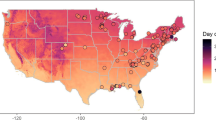Abstract
We evaluated spring phenology changes from 1965 to 2001 in northeastern USA utilizing a unique data set from 72 locations with genetically identical lilac plants (Syringa chinensis, clone “Red Rothomagensis”). We also utilized a previously validated lilac-honeysuckle “spring index” model to reconstruct a more complete record of first leaf date (FLD) and first flower date (FFD) for the region from historical weather data. In addition, we examined mid-bloom dates for apple (Malus domestica) and grape (Vitis vinifera) collected at several sites in the region during approximately the same time period. Almost all lilac sites with significant linear trends for FLD or FFD versus year had negative slopes (advanced development). Regression analysis of pooled data for the 72 sites indicated an advance of −0.092 day/year for FFD (P=0.003). The slope for FLD was also negative (−0.048 day/year), but not significant (P=0.234). The simulated data from the “spring index” model, which relies on local daily temperature records, indicated highly significant (P<0.001) negative slopes of −0.210 and −0.123 day/year for FLD and FFD, respectively. Data collected for apple and grape also indicated advance spring development, with slopes for mid-bloom date versus year of −0.20 day/year (P=0.01) and −0.146 (P=0.14), respectively. Collectively, these results indicate an advance in spring phenology ranging from 2 to 8 days for these woody perennials in northeastern USA for the period 1965 to 2001, qualitatively consistent with a warming trend, and consistent with phenology shifts reported for other mid- and high-latitude regions.






Similar content being viewed by others
References
Abu-Asab M, Peterson PM, Shetler SG, Orli SS (2001) Earlier plant flowering in spring as a response to global warming in the Washington, D.C., area. Biodivers Conserv 10:597–612
Badeck F-W, Bondeau A, Bottcher K, Doktor D, Lucht W, Schaber J, Sitch S (2004) Responses of spring phenology to climate change. New Phytol 162:295–309
Bradley NL, Leopold AC, Ross J, Huffaker W (1999) Phenological changes reflect climate change in Wisconsin. Proc Natl Acad Sci USA 96:9701–9704
Cayan DR, Kammerdiener SA, Dettinger MD, Caprio JM, Peterson DH. (2001) Changes in the onset of spring in the western United States. Bull Am Meteorol Soc 82(3):399–415
Chmielewski FM (1996) The international phenological gardens across Europe: present state and perspectives. Phenol Season 1:19–23
Dube PA, Perry LP, Vittum MT (1984) Instructions for phenological observations: lilac and honeysuckle. Vermont Agric Exp Sta Bull 692, University of Vermont, Burlington
Fitter AH, Fitter RSR (2002) Rapid changes in flowering time in British plants. Science 296:1689–1691
Hopp RJ (1974) Plant phenology observation networks. In: Lieth H (ed) Phenology and seasonality modeling. Springer, Berlin Heidelberg New York, pp 25–43
Ihne E (1885) Karte der Aufbluhzeit von Syringa vulgaris in Europa. Bot Centralbl 21:85–88
Keeling CD, Chin JFS, Whorf TP (1996) Increased activity of northern vegetation inferred from atmospheric CO2 measurements. Nature 382:146–149
Lechowicz MJ, Koike T (1995) Phenology and seasonality of woody plants: an unappreciated element in global change research?. Can J Bot 73:147–148
Menzel A (2000) Trends in phenological phases in Europe between 1951 and 1996. Int J Biometeorol 44:76–81
Menzel A, Estrelly N, Fabian P (2001) Spatial and temporal variability of the phenological season in Germany from 1951–1996. Global Change Biol 7:657–666
Nienstaedt H (1974) Genetic variations in some phonological characteristics of forest trees. In: Lieth H (ed) Phenology and seasonality modeling. Springer, Berlin Heidelberg New York, pp 389–400
Parmesan C, Yohe G (2003) A globally coherent fingerprint of climate change impacts across natural systems. Nature 421:37–42
Penuelas J, Filella I (2001) Responses to a warming world. Science 294:793–795
Penuelas J, Filella I, Comas P (2002) Changed plant and animal life cycles from 1952 to 2000 in the Mediterranean region. Global Change Biol 8:531–544
Schnelle F, Volkert E (1974) International phenological gardens in Europe: The basic network for international phenological observations. In: Lieth H (ed) Phenology and seasonality modeling. Springer, Berlin Heidelberg New York, pp 25–43
Schwartz MD (1999) Advancing to full bloom: planning phenological research for the 21st century. Int J Biometeorol 42:113–118
Schwartz MD (1997) Spring index models: an approach to connecting satellite and surface phenology. In: Lieth H, Schwartz MD (eds) Phenology of seasonal climates. I. Backhuys, The Netherlands, pp 23–38
Schwartz MD (1994) Monitoring global change with phenology: the case of the spring green wave. Int J Biometeorol 38:18–22
Schwartz MD, Reiter BE (2000) Changes in North American spring. Int J Climatol 20:929–932
Seem RC, Szkolnik M (1978) Phenological development of apple trees. In: Hopp RJ (ed) Phenology: an aid to agricultural technology. Vermont Agricultural Experiment Station Bulletin 684. University of Vermont, Burlington, pp. 16–20
Walther G-R, Post E, Convey P et al (2002) Ecological responses to recent climate change. Nature 416:389–395
Winkler AJ, Cook JA, Kliewer WM, Lider LA (1974) General viticulture. University of California Press, Berkeley
Zhao T, Schwartz MD (2003) Examining the onset of spring in Wisconsin. Climate Res 24:59–70
Zhou L, Tucker CJ, Kaufman RK, Slayback D, Shabanov NV, Myneni RB (2001) Variations in northern vegetation activity inferred from satellite data of vegetation index during 1981–99. J Geophys Res 16:20069–20083
Acknowledgements
This work was funded in part by a grant from the USDA Special Grants-Agriculture Ecosystems Program (No. 91-34244-7419). Historical lilac phenology data collection was funded by USDA NE-35 and NE-69 Regional Hatch grants. The authors thank Keith Eggleston of the Northeast Regional Climate Center for help in accessing weather records, and Jeff Piestrak of Mann Library at Cornell University for assistance with GIS mapping. We thank Cornell University Agriculture Experiment Station faculty and staff who participated in the collection of apple and grape phenology data, and volunteers throughout northeastern USA who have participated in the lilac phenology network
Author information
Authors and Affiliations
Corresponding author
Rights and permissions
About this article
Cite this article
Wolfe, D.W., Schwartz, M.D., Lakso, A.N. et al. Climate change and shifts in spring phenology of three horticultural woody perennials in northeastern USA. Int J Biometeorol 49, 303–309 (2005). https://doi.org/10.1007/s00484-004-0248-9
Received:
Revised:
Accepted:
Published:
Issue Date:
DOI: https://doi.org/10.1007/s00484-004-0248-9




